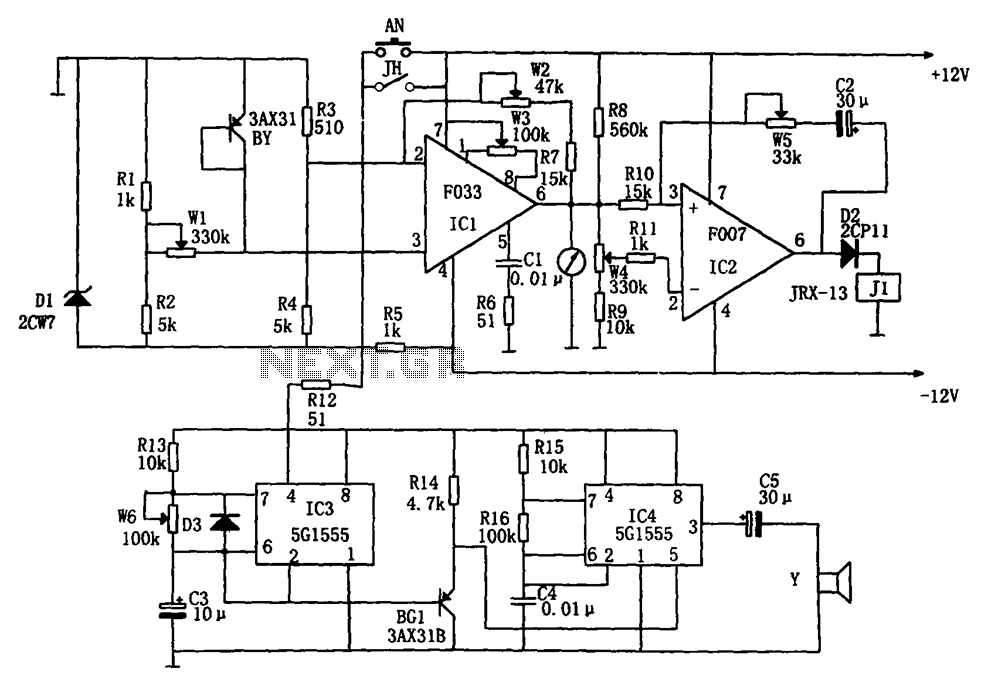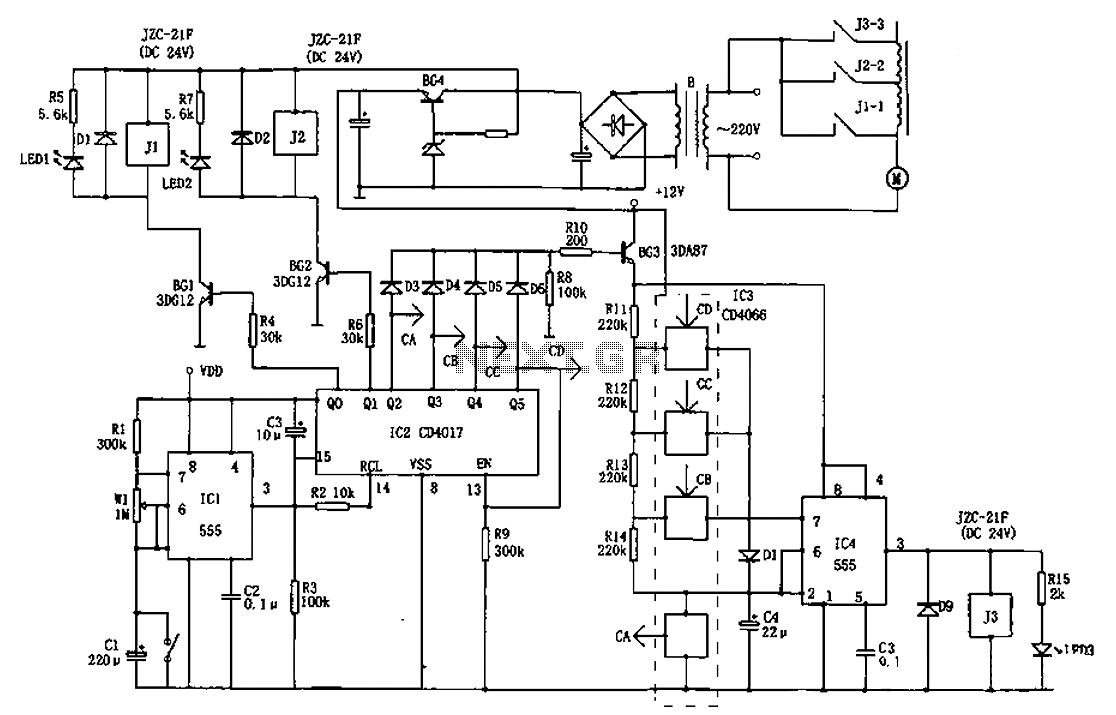
Schematic Diagram Schema HO Train Model Lighthouse Flasher

The aboriginal accessory forms a typical oscillator circuit that produces both a triangle waveform signal and a square wave signal. The triangle signal is fed into a voltage regulator circuit, which converts the triangle voltage signal to a triangle current signal through the LED. The square wave signal is first sent through a capacitor and then to a power FET transistor. This generates a high current pulse through the LED, with the appropriate timing to create a strobe effect. The result is an LED that gradually brightens, then flashes even brighter before dimming again. This should produce a light that simulates a rotating alarm light.
The circuit described employs a typical oscillator configuration that generates two distinct waveforms: a triangle waveform and a square waveform. The triangle waveform is essential for controlling the brightness of an LED through a voltage regulator circuit. The voltage regulator ensures that the LED receives a stable current, which is critical for achieving consistent brightness levels. The triangle waveform, characterized by its linear rise and fall, allows for a gradual increase in LED brightness, creating a smooth lighting effect.
The square waveform plays a crucial role in generating the strobe effect. After passing through a capacitor, the square wave is directed to a power FET (Field Effect Transistor). The FET is utilized for its high current handling capabilities, allowing it to drive the LED with significant power. The timing of the square wave is designed to produce rapid on-off cycles, resulting in a high current pulse that causes the LED to flash brightly.
The strobe effect is achieved by carefully timing the transitions between the LED's bright and dim states. Initially, the LED gradually brightens as the triangle waveform increases, creating a soft glow. Once it reaches a peak brightness, the square waveform takes over, rapidly pulsing the LED to an even brighter state before allowing it to dim again. This sequence simulates the appearance of a rotating alarm light, which is often used in emergency signaling applications.
Overall, this oscillator circuit effectively combines both waveforms to create a visually striking lighting effect suitable for various applications, including decorative lighting, signaling devices, and alarm systems. The design emphasizes the importance of waveform characteristics in achieving specific visual outcomes, demonstrating the versatility of oscillator circuits in electronic design.The aboriginal accessory forms a archetypal oscillator ambit whose achievement is both a triangle waveform arresting and a aboveboard beachcomber signal. The triangle arresting is baffled to a accepted regulator circuit, which converts the triangle voltage arresting to a triangle accepted arresting through the alarm LED.
The aboveboard beachcomber arresting is aboriginal beatific through a capacitor afresh to a ability FET transistor. This produces a aerial accepted beating through the LED, with the appropriate timing to aftermath a strobe effect. The aftereffect is a LED, which gradually grows brighter, afresh flashes alike brighter afore concealment again.
This should aftermath a light, which simulates a alternating alarm light. 🔗 External reference
The circuit described employs a typical oscillator configuration that generates two distinct waveforms: a triangle waveform and a square waveform. The triangle waveform is essential for controlling the brightness of an LED through a voltage regulator circuit. The voltage regulator ensures that the LED receives a stable current, which is critical for achieving consistent brightness levels. The triangle waveform, characterized by its linear rise and fall, allows for a gradual increase in LED brightness, creating a smooth lighting effect.
The square waveform plays a crucial role in generating the strobe effect. After passing through a capacitor, the square wave is directed to a power FET (Field Effect Transistor). The FET is utilized for its high current handling capabilities, allowing it to drive the LED with significant power. The timing of the square wave is designed to produce rapid on-off cycles, resulting in a high current pulse that causes the LED to flash brightly.
The strobe effect is achieved by carefully timing the transitions between the LED's bright and dim states. Initially, the LED gradually brightens as the triangle waveform increases, creating a soft glow. Once it reaches a peak brightness, the square waveform takes over, rapidly pulsing the LED to an even brighter state before allowing it to dim again. This sequence simulates the appearance of a rotating alarm light, which is often used in emergency signaling applications.
Overall, this oscillator circuit effectively combines both waveforms to create a visually striking lighting effect suitable for various applications, including decorative lighting, signaling devices, and alarm systems. The design emphasizes the importance of waveform characteristics in achieving specific visual outcomes, demonstrating the versatility of oscillator circuits in electronic design.The aboriginal accessory forms a archetypal oscillator ambit whose achievement is both a triangle waveform arresting and a aboveboard beachcomber signal. The triangle arresting is baffled to a accepted regulator circuit, which converts the triangle voltage arresting to a triangle accepted arresting through the alarm LED.
The aboveboard beachcomber arresting is aboriginal beatific through a capacitor afresh to a ability FET transistor. This produces a aerial accepted beating through the LED, with the appropriate timing to aftermath a strobe effect. The aftereffect is a LED, which gradually grows brighter, afresh flashes alike brighter afore concealment again.
This should aftermath a light, which simulates a alternating alarm light. 🔗 External reference




